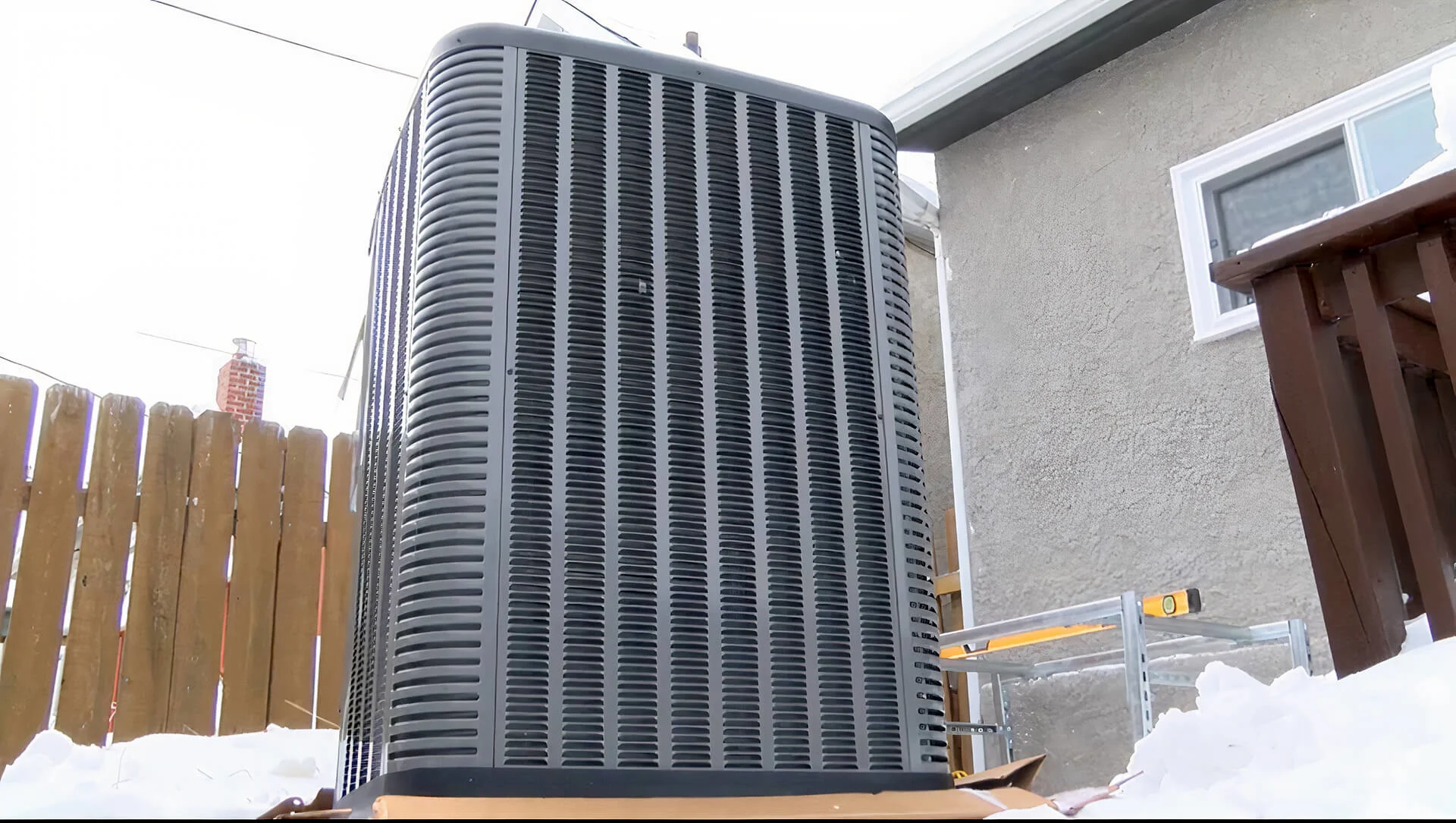
Can heat pumps handle winters in Canada’s coldest cities?
Heat pump technology is being touted for its efficiency and cost effectiveness as an alternative to oil and gas furnaces, and it even works in some of Canada’s coldest climates. But there are a few considerations when contemplating the transition.
During the coldest days on the Canadian Prairies, as the snow blows across the neverending flatness, it hits you how astonishing it is that humans are even able to live in this snowscape. But when you also see that one of the largest source of emissions in Canada is space heating, it isn’t terribly shocking.
In 2020, approximately 38 megatonnes of CO2 (or roughly six per cent of the national total) was emitted to heat homes in this country. Residential heating and personal transportation are the two biggest areas Canadians have direct power over lowering the country’s emissions profile, without having to rely on changes at the industrial or governmental level.
Thankfully, advancing technology in this area — especially in the realm of air-source heat pumps — is making it more affordable and more efficient than ever before for people to take this challenge into their own hands. This is also the case even in Canada’s coldest cities, like Winnipeg.
How do I know? Because I put one in my own home. But throughout the experience it was clear that information on how this technology works in colder climates was lacking, and contractors often provided conflicting information. So here are some handy tips I picked up along the way for those thinking about installing a heat pump in their home.
Why is choosing a heat pump a climate-friendly choice?
Different provinces face different circumstances when it comes to electricity generation profiles. But in Manitoba, for example, electricity comes almost entirely from hydroelectric dams, which are low-emissions. Thus, for those trying to lower the emissions profile of their home, moving to an electric heat source is a sensible choice. And air-source heat pumps are an efficient electric heat source, which means they both displace natural gas use, and draw a lower demand from the electricity grid than resistance heating.
By exchanging my natural gas furnace for a heat pump with an electric backup (and changing out my natural gas water heater for an electric one) I effectively made my century-home into a zero-emissions house.
Based on the Energuide ratings that were done before and after the upgrades, this lowered the emissions generated by my 1,200-square-foot home by 11.3 tonnes annually.

Before and after calculations for potential emissions reduction with a heat pump upgrade. (Submitted by Sarah Lawrynuik)
Additionally, installing a heat pump decreases the amount of energy needed to heat and cool your home because they’re so efficient (yes, it also operates as an air conditioner). This can be capitalized on when paired with other upgrades to a home such as new windows or increased insulation.
In my case, the amount of energy needed was cut in half.

Before and after home energy assessment. (Submitted by Sarah Lawrynuik)
Will it really work? Even in Winnipeg?
The short answer here is: of course! But the long answer is: in colder climates heat pumps do need a little extra help.
The air-source heat pump uses the same technology as an air conditioner but with a reverse valve, allowing for the machine to also produce heat.
These units are incredibly efficient at both heating and cooling. But as the temperature drops in the winter, the unit will start becoming less efficient at heating, and when the temperature drops to a certain point, the unit will stop operating altogether. Where this shutoff point is depends on the unit but ranges from -12 C to -25 C.
There are a lot of days in Winnipeg where it does drop below those thresholds, and that is why air-source heat pumps in Canada come with a backup heat source, which can either be electric or natural gas fueled.
You might ask: “Is this the same as having two furnaces?” The answer is yes, kind of. But for most of the year, the backup won’t be operational.
So in my case, I opted for an electric backup (to minimize emissions), which means in the air exchange unit that pushes the heat pump’s warm air around my house, there lives a 20-kilowatt electric coil that kicks in as needed. And the changeover between the heat pump and the electric coil is all orchestrated by my new smart thermostat (which is a required feature that comes along with most heat pumps).
“The thermostat is going to take care of doing all of your changeover,” said Scott Halford, contractor with Walmer Mechanical. “So basically there's an outdoor sensor that takes the air temperature and basically it's programed to know when it's too cold or when the heat pump is going into too many defrost cycles, then it's just going to switch over to your backup.”
Watch below: Everything you need to know about heat pumps
Walmer Mechanical mostly focuses on commercial clients in Winnipeg, but Halford said they are installing about one heat pump a month for residential clients now, even if natural gas remains the more popular choice.
Mark Desjardins was among the first of Halford’s clients to make the leap to an air-source heat pump in 2018 and it’s a decision that has made Desjardins into a heat pump evangelical, telling anyone he can about how wonderfully efficient the system is, and how it’s actually made his home more comfortable. This is mainly, he said, because the heat pump and the backup offer a low level but constant stream of heat, instead of blasts of hot air followed by shut offs as is typical with natural gas furnaces.
“You can't, in Manitoba, use a heat pump all year round — you need the backup. But my heat pump has run in every month of the year,” Desjardins said. “It runs often in December, and it’s run in January and February.”
How do I get all the government incentives?
The federal government, helped along with provincial and regional programs, has created a green energy incentive program that makes the air-source heat pump a financially much more attractive option, too. Navigating these programs and making sure you have all your Is dotted and Ts crossed can be tricky but is manageable.
The federal program has two core pieces a grant of up to $5,000, which is money you can keep that goes against the price of the unit. And the second party is a zero-interest loan of up to $40,000. You have to pay this money back, but over 10 years, and considering interest rates these days (!) zero per cent is a steal.
You can sign up and find more information on the federal government’s Greener Homes Initiative portal.
There are a lot of heat pumps out there with premiere lines like Carrier and Lennox typically being the most expensive. But there are less expensive options that compete with those brands on efficiency. Check the federal registry and with your contractor to see what trade offs you’re happy with when it comes to efficiency, cost, and rebate amount.
In my case, I went with a Ruud high-efficiency cold-climate heat pump. A product like this is eligible for the $5,000 grant as well as $10,000 of loan funding.
And it’s important before you start the work to check for provincial and municipal programs that might help finance the project too. In Manitoba, for example, a new heat pump incentive program has been started which evaluates rebates based on the model chosen and size of the home. But the upgrade must be approved by Efficiency Manitoba before install in order to be eligible, so make sure you’re checking the right order of things. Check with your provincial efficiency hub to see what you might be eligible for.
It is not until your upgrades are done, your invoices are paid and the evaluation is complete that you will be eligible to start receiving the incentive funds. Keep that in mind if purse strings are tight.

Heat pump installation in Winnipeg.
Does this make sense financially?
How much financial sense a heat pump makes depends on your circumstances.
For me, I was looking at having to replace an ancient natural gas furnace, and as summers have become nearly unbearable in Winnipeg without air conditioning, that was also on my to-do list.
Those costs, when paired with the federal and provincial incentives made installing a heat pump a financially competitive option too. One that is likely also to save me money on my monthly energy bills.
“In some situations it seems like a no brainer, especially with the grant program,” Halford said. “Because if you're already spending, let's say, to replace your furnace and air conditioner, it's going to cost you up to $12,000. Or you could upgrade to some of the highest end heat pumps out there and it's only a fraction more.”
Let’s run the math on my system. The heat pump and electric back up cost $16,659 before tax to have installed, minus $5,000 in federal incentives, minus $1,600 in provincial incentives. That’s $10,059 which is approximately the same amount that I could finance in a zero-interest loan paid back over a decade.
There was one extra cost added to my plate, as my electrical panel needed to be upgraded to support the new system, which ran an extra $5,000.
But the alternative was to front up to $12,000 in cash for a natural gas system and A/C unit, or pay high interest rates on a bank loan.
Climate choices are finally starting to make financial sense to homeowners, too.
Late in 2022, Natural Resources Canada released a report demonstrating that in nearly all Canadian locales, operating costs of a heat pump would also be lower than the natural gas alternative — the lone exceptions were Winnipeg and Prince George, B.C. In these climates, the report says users might end up spending more to heat/cool their home because of the drop in efficiency experienced in the winter.
However, that’s not been Desjardins’ experience. “My gas has gone down and my electricity has gone down. So there is a big savings,” he said.
As someone who tracks his electricity usage meticulously, he found that in the years since his heat pump installation his electricity use has dropped by more than 16 per cent and his natural gas has fallen by nearly 18 per cent.

Table via Natural Resources Canada.
Other things to know before you start
There are a few things that I wish I’d known before I set out down this road, and I hope they will be of use to anyone who tries to do the same.
The application process is easy, but with the onslaught of people applying to the federal incentive programs, wait times for inspectors to come can be long. It pays to call each of the companies on the providers list and see who has shorter wait times because they can vary a great deal.
Be aware when setting up the energy adviser evaluations that between the two visits, before and after the upgrades, it will cost more than $600 which is the maximum amount the federal government will reimburse. When you’re calling advisers, also ask what they charge because it can vary significantly. (For rural residents, there is also often a surcharge for travel.)
You are responsible for fronting all of the costs for installation and inspections even if the government grants and loans are approved. Cash does not start flowing to you until all work is completed, inspected and paid for.
The biggest thing that will lower the effectiveness of a heat pump is air ducts that are too narrow. Make sure your contractor is confident your home’s ducts are wide enough to supply sufficient air flow.
Thumbnail image: Exterior view of a heat pump installation in Winnipeg. (Submitted by Sarah Lawrynuik)










